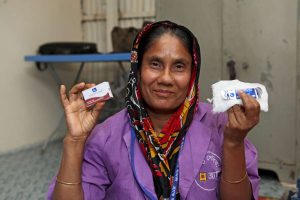Reading Time: 2 minutes
The BRAC birthing kit is a small packet wrapped in plastic, about the size of a Pop-Tart, and it’s saving lives. This packet is an excellent example of jugaad, one of the buzzwords making the rounds in the business world.
Jugaad is a colloquial term in Hindi for an innovative fix or improvised solution – a frugal innovation.
The BRAC birthing kit is a small packet wrapped in plastic, about the size of a Pop-Tart, and it’s saving lives. This packet is an excellent example of jugaad, one of the buzzwords making the rounds in the business world.
Jugaad is a colloquial term in Hindi for an innovative fix or improvised solution – a frugal innovation.
In the developing world, life often runs on jugaad solutions. According to the authors of Jugaad Innovation: Think Frugal, Be Flexible, Generate Breakthrough Growth, western businesses could learn a lot from the jugaad approach of innovation and radical affordability.
Development organizations, too, must create inexpensive and adaptable solutions to alleviate poverty. The BRAC birthing kit is one such example.
Founded in Bangladesh in 1972, BRAC has grappled with the problem of high maternal and infant mortality in a country where the vast majority of women still give birth at home without a skilled attendant. Your response might be to build more or bigger hospitals; BRAC instead brought suitable alternatives to the women themselves, in the form of “birthing huts” in the slums of Dhaka and other Bangladeshi cities, as well as the BRAC birthing kits.
A BRAC birthing kit contains the necessary tools for a safe and sterile delivery: gauze, carbolic soap, a sterile plastic sheet to go over the mattress, a thread to tie the umbilical cord and a surgical blade to cut it. That’s it.
It might not be the most elegant solution, but it transforms any home into a safe and sterile place to have a baby. The cost to the consumer? A mere 40 cents.
By slimming the product down to the bare necessities, the birthing kit is simple to manufacture and distribute. At the Sanitary Napkin and Delivery Kits unit, a BRAC social enterprise, the kit costs 28 cents to make. It is then sold to BRAC’s Health Program for 32 cents, the same price at which it is sold to BRAC community health promoters, or shasthya shebikas in Bengali. These women are trained by BRAC and, as part of a range of products and services they provide, sell the kits for 40 cents to their community.
Since 1999, BRAC has manufactured more than 2.6 million of these.
Of course, it’s not enough to only have a birthing kit. A skilled attendant is still necessary to manage complications. You might think it’s time to send in the doctors, but BRAC learned that with a bit of training – and access to a network of qualified help should complications arise – women from the community can be trained to be skilled birth attendants.
BRAC has made headway in frugal innovation by providing products and services that are affordable, accessible, and – crucially – relevant to those being served. BRAC has already seen measurable results; meanwhile Bangladesh is well on its way to reducing maternal and child mortality by the 2015 deadline of the UN Millennium Development Goals.
When people can afford the tangible and intangible costs of basic services, they are better positioned to mobilize themselves economically and socially. Poverty is not unique to the developing world, but what is the west providing in terms of low-cost solutions? Perhaps the developed world can take a lesson or two from frugal innovation.
Here’s what they look like on the inside:
By Renée McAlpin
Program Intern at BRAC USA







